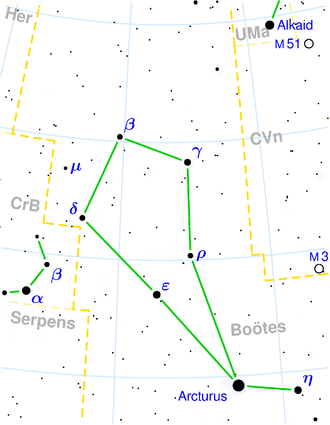NGC 5557
| Galaxy NGC 5557 |
|
|---|---|
![NGC 5557 [1] SDSS image](https://upload.wikimedia.org/wikipedia/commons/thumb/f/f5/NGC5557_-_SDSS_DR14.jpg/300px-NGC5557_-_SDSS_DR14.jpg)
|
|
| NGC 5557 SDSS image | |
| AladinLite | |
| Constellation | Bear keeper |
|
Position equinox : J2000.0 , epoch : J2000.0 |
|
| Right ascension | 14 h 18 m 25.724 s |
| declination | + 36 ° 29 ′ 36.82 ″ |
| Appearance | |
| Morphological type | E1 |
| Brightness (visual) | 10.9 likes |
| Brightness (B-band) | 11.9 likes |
| Angular expansion | 2.4 ′ × 1.9 ′ |
| Position angle | 105 ° |
| Surface brightness | 12.6 mag / arcmin² |
| Physical data | |
| Affiliation | NGC 5557 group LGG 378 |
| Redshift | 0.010737 ± 0.000017 |
| Radial velocity | 3219 ± 5 km / s |
|
Stroke distance v rad / H 0 |
(147 ± 10) · 10 6 ly (45.2 ± 3.2) Mpc |
| history | |
| discovery | William Herschel |
| Discovery date | May 1, 1785 |
| Catalog names | |
| NGC 5557 • UGC 9161 • PGC 51104 • CGCG 191-074 • MCG + 06-31-093 • 2MASX J14182570 + 3629372 • GC 3843 • H I 99 • h 1776 • GALEX ASC J141825.62 + 362935.8 • LDCE 1052 NED004 | |
NGC 5557 is an elliptical galaxy from the Hubble type E1 in the constellation Bootes the northern sky . It is estimated to be 147 million light-years from the Milky Way and about 100,000 light-years across. Together with five other galaxies, it forms the NGC 5557 group ( LGG 378 ).
In the same area of the sky are u. a. the galaxies NGC 5529 , NGC 5544 , NGC 5545 , NGC 5572 .
The Type Ia supernovae SN 1996aa and SN 2013gn were observed here.
The object was discovered by William Herschel on May 1, 1785 .
NGC 5557 group ( LGG 378 )
| Galaxy | Alternative name | Distance / million Lj |
|---|---|---|
| NGC 5544 | PGC 51018 | 140 |
| NGC 5545 | PGC 51023 | 140 |
| NGC 5557 | PGC 51104 | 147 |
| NGC 5589 | PGC 51300 | 155 |
| NGC 5590 | PGC 51312 | 147 |
| NGC 5596 | PGC 51355 | 143 |
Web links
- SIMBAD Astronomical Database
- Spektrum.de: Surrounding area
